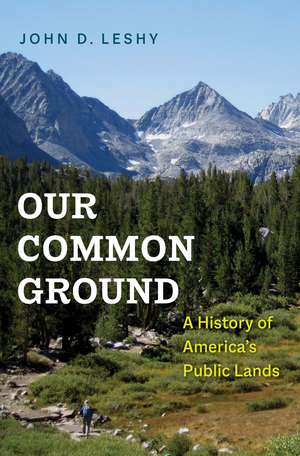Our Common Ground: A History of America's Public Lands
Autor John D. Leshyen Limba Engleză Hardback – 2 mai 2022
“A much-needed chronicle of how the American people decided—wisely and democratically—that nearly a third of the nation’s land surface should remain in our collective ownership and be managed for our common good.”—Dayton Duncan, author of The National Parks: America’s Best Idea
America’s public lands include more than 600 million acres of forests, plains, mountains, wetlands, deserts, and shorelines. In this book, John Leshy, a leading expert in public lands policy, discusses the key political decisions that led to this, beginning at the very founding of the nation. He traces the emergence of a bipartisan political consensus in favor of the national government holding these vast land areas primarily for recreation, education, and conservation of biodiversity and cultural resources.
That consensus remains strong and continues to shape American identity. Such a success story is a bright spot in an era of cynicism about government. This book is essential reading for anyone who cares about public lands, and it is particularly timely as the world grapples with the challenges of climate change and biodiversity loss.
Preț: 258.90 lei
Preț vechi: 281.70 lei
-8% Nou
Puncte Express: 388
Preț estimativ în valută:
49.54€ • 51.19$ • 41.21£
49.54€ • 51.19$ • 41.21£
Comandă specială
Livrare economică 05-19 martie
Doresc să fiu notificat când acest titlu va fi disponibil:
Se trimite...
Preluare comenzi: 021 569.72.76
Specificații
ISBN-13: 9780300235784
ISBN-10: 030023578X
Pagini: 736
Ilustrații: 22 b-w illus.
Dimensiuni: 156 x 235 x 46 mm
Greutate: 1.2 kg
Editura: Yale University Press
Colecția Yale University Press
ISBN-10: 030023578X
Pagini: 736
Ilustrații: 22 b-w illus.
Dimensiuni: 156 x 235 x 46 mm
Greutate: 1.2 kg
Editura: Yale University Press
Colecția Yale University Press
Recenzii
“Our Common Ground is a notable scholarly achievement, providing an authoritative history of federal land law and administration. . . . There is an efficiency and elegance in Leshy’s writing. . . . As a result, this isn’t just an authoritative reference book; it is an enjoyable read.”—James R. Skillen, Utah Historical Quarterly
“An exceptionally readable and comprehensive history of US public lands.”—Z. Albertson, Choice
“I found Our Common Ground to be quite a lively read. . . . The book is replete with interesting stories, told through the passage of time and the evolving notions of what America’s public lands are for.”—Andy Kerr
“Finally, we have a truly great book about the federal public lands. John Leshy has used his unequalled knowledge and engaging style to write a comprehensive, inspiring, and lastingly informative masterpiece.”—Charles Wilkinson, author of Crossing the Next Meridian: Land, Water, and the Future of the West
“Our Common Ground is a much-needed chronicle of how the American people decided—wisely and democratically—that nearly a third of the nation’s land surface should remain in our collective ownership and be managed for our common good.”—Dayton Duncan, author of The National Parks: America’s Best Idea
“This history of public lands in America, reflecting prodigious research, illustrates the continuity, tensions, and narratives that persist through time to the present. What a rich history, richly presented. I could not put down this book!”—Lynn Scarlett, former deputy secretary, U.S. Department of the Interior
“Read John Leshy’s masterpiece! John shows us that by questioning and reframing our European-centric public lands history we can begin to right the wrongs of the past. And if we get it right, find common purpose and keep our covenant with future Americans.”—Mark Udall, former U.S. senator, Colorado
“An exceptionally readable and comprehensive history of US public lands.”—Z. Albertson, Choice
“I found Our Common Ground to be quite a lively read. . . . The book is replete with interesting stories, told through the passage of time and the evolving notions of what America’s public lands are for.”—Andy Kerr
“Finally, we have a truly great book about the federal public lands. John Leshy has used his unequalled knowledge and engaging style to write a comprehensive, inspiring, and lastingly informative masterpiece.”—Charles Wilkinson, author of Crossing the Next Meridian: Land, Water, and the Future of the West
“Our Common Ground is a much-needed chronicle of how the American people decided—wisely and democratically—that nearly a third of the nation’s land surface should remain in our collective ownership and be managed for our common good.”—Dayton Duncan, author of The National Parks: America’s Best Idea
“This history of public lands in America, reflecting prodigious research, illustrates the continuity, tensions, and narratives that persist through time to the present. What a rich history, richly presented. I could not put down this book!”—Lynn Scarlett, former deputy secretary, U.S. Department of the Interior
“Read John Leshy’s masterpiece! John shows us that by questioning and reframing our European-centric public lands history we can begin to right the wrongs of the past. And if we get it right, find common purpose and keep our covenant with future Americans.”—Mark Udall, former U.S. senator, Colorado
Notă biografică
John D. Leshy is emeritus professor, University of California Hastings College of Law. He was solicitor for the U.S. Department of the Interior from 1993 to 2001 and is coauthor of Federal Public Land and Resources Law.
Descriere
The little-known story of how the U.S. government came to hold nearly one-third of the nation’s land and manage it primarily for recreation, education, and conservation
